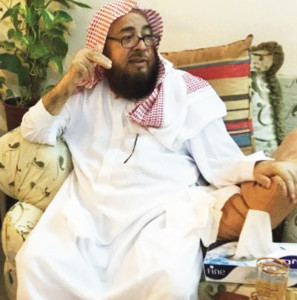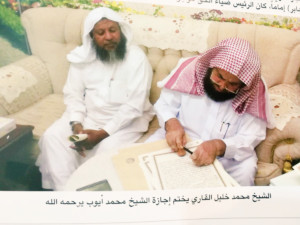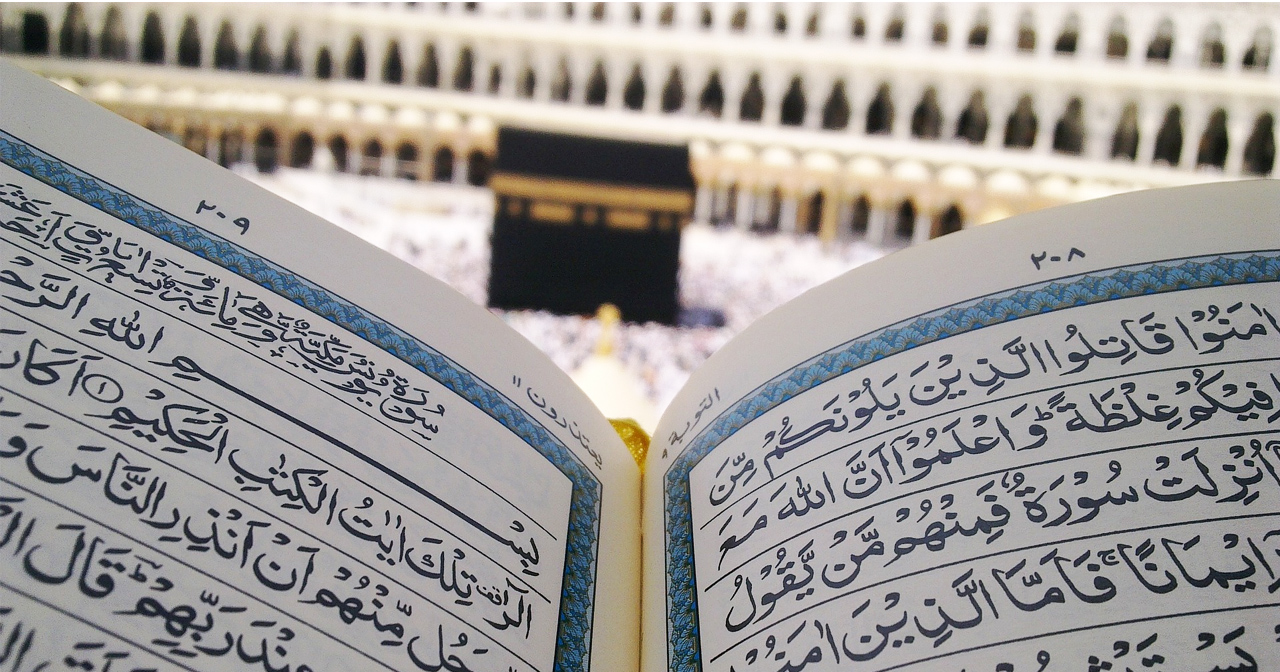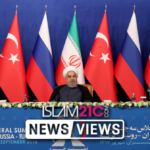Throughout life we will always find shining exemplars of selfless servitude and dedication to a cause greater than themselves. People whose legacy of goodness remains long after they have departed from this world and their own hands no longer toil. Whether they are the Imām Bukhārīs of ḥadīth, the Imām Shāfiʿīs of fiqh or from more contemporary examples of selflessness and charity, the ʿAbdur-Raḥmān as-Sumaits,[1] or ʿAbdus-Sattār Edhis.[2] These people lived and breathed the principles they held tight to, continuing to affect the world long after their departure from this temporal existence.
Of the noblest pursuits in existence, one in particular stands out from these words of the Prophet ﷺ :
خَيْرُكُمْ مَنْ تَعَلَّمَ الْقُرْآنَ وَعَلَّمَهُ
“The best of you are those who learn the Qurʾān and teach it.”[3]
On the 23rd of Dhul Ḥijjah 1439 (Monday 3rd September 2018) the blessed city of Madīnah witnessed the passing of one of the Muslim world’s greatest scholars of and contributors to the teaching of the Qur’an, Shaykh Khalīl ʿAbdul-Rahman al-Qāriʾ, may Allāh have mercy on him. Known by many as the Shaykh of the Qurrāʾ, countless students graduated in Qurʾān memorisation and studies under his tutelage including many scholars and Imāms of the Two Sacred Mosques. He was amongst the group who began one of Saudi Arabia’s largest network of Qurʾān schools through the establishment of the charity al-Jamʿiyāt al-Khayriyyah li-Taḥfīḏh al-Qurʾān al-Karīm due (surprisingly judging by the location) to the dire need for qualified, high quality students of the Qurʾān in Makkah. His story is also an inspiring example of how non-Arab Islāmic scholarship throughout history, especially where it concerned the sciences of the Qurʾān, was instrumental in academic development and dissemination as well as a mastery from which even Arabs to this day benefit. A clear evidence of the universality of Islāmic teachings.

Early Life
Shaykh Khalīl al-Qāriʾ was born in the year 1358 Hijrī (1939) in Muzaffarabad, Azad Kashmir, Pakistan where he lived until the age of nine receiving his primary education. He then moved with his family to the city of Lahore where he completed his secondary education. He attended a well-known Qurʾān school known for producing high quality Qurrāʾ, excelling in their recitation and implementation of correct tajwīd. He shined from the very beginning and the school’s head, Shaykh Faḍl al-Karīm Mehtāb al-Dīn noticed his proficiency and took him as a personal student. A tough teacher, he would not accept more than a single mistake when revising the mutashābihāt verses (verses resembling others which are generally a little difficult) and no mistakes on any other verses. After a number of years in Lahore studying with various other scholars and gaining ijazāt he returned to Muzaffarabad where he taught in a large Qurʾān school and recited regularly on a radio station.
Establishment of Makkan Ḥifḏh Schools and His Role
Shaykh Khalīl al-Qāriʾ’s journey to the city of revelation, Makkah was one most unexpected as often what Allāh decrees is vastly different from what plans we ourselves make. The initial spark was a chance event ordained by Allāh in the year 1380 Hijrī (1961). In Ramaḍān of that year, the Imām of al-Masjid al-Ḥarām, a distinguished Egyptian Azharī scholar by the name of Shaykh ʿAbdul-Muhaymin Abū al-Samāḥ fell ill and was unable to lead the tarāwīḥ prayers in the Grand Mosque as he had done for many years. For some reason, the authorities were unable to find a suitable replacement, surprising for the city of Makkah you may think. Without many options, they tasked the Imām of the quiet prayers (Ḏhuhr and ʿAṣr) to take his place. This Imām was neither a ḥāfiḏh nor accustomed to the pressure of loud prayers and so constantly made mistakes. The congregation slowly left him and refused to pray behind him from the next night onward.
In those days due to the difficulty of the journey, pilgrims attending Ḥajj would often arrive before Ramaḍān spending the month there and then leaving once the Ḥajj was complete. Consequently, different congregations who refused to pray behind this Imām began to form throughout the masjid; each behind a ḥāfiḏh Imām who had travelled as part of their group owing to the dearth of local ḥuffaḏh.
Of the many worshippers in attendance that Ramaḍān was a Pakistani dāʿī by the name of Moḥammed Yūsuf Sītī. His father was a Hindu convert. Moḥammed Yūsuf was raised in a household loving the Qurʾān. He was the educational equivalent of Abdus Sattār Edhi, having established over 335 high quality Qurʾān schools throughout Pakistan and Bangladesh with over 30,000 students in total. Moḥammed Yūsuf was in attendance in the Ḥaram that year with a group of senior Pakistani scholars, one of whom witnessed this incredulous occurrence (being unable to find a suitable Imām for the Ḥaram in Makkah of all places) and suggested to Moḥammed Yūsuf that he take his efforts from Pakistan and work them in Makkah in establishing the same network of high quality madāris using his tried and tested model.
He was taken aback by this suggestion as it had never occurred to him the city of revelation would ever require such a thing. He took the suggestion and ran with it as he was by his nature a highly motivated individual once an idea made itself manifest.
He began by researching the current state of the numerous Qurʾān schools in Makkah, examining their teaching methods, the proficiency of their teachers and the progress of their students. What he found as a highly experienced school manager and founder left much to be desired. Teaching methods were poor, students were generally weak in their understanding and memorisation and they were in dire need of higher quality tutelage and better methods.
Moḥammed Yūsuf returned to Pakistan set on his vision. He consulted a number of his peers in formulating a blueprint for a successful Qurʾān school model. In 1381 Hijrī (1961) he took the first step in searching for a suitable head teacher, one who was skilled and pious, one who would inspire his students to be the best they could be.
He had shortlisted a few names, the topmost being Shaykh Khalīl al-Qāriʾ, known by that time for his skilful recitation at the Muzaffarabad radio station he recited at and for his success in producing high quality students at a school established by Moḥammed Yūsuf in Azad Kashmir. It was by a twist of Qadr ordained, that the two would meet soon after in Karachi.
Shaykh Khalīl al-Qāriʾ after some time teaching in the madrassah decided he would continue seeking knowledge, enrolling at the prestigious al-Azhar university in Cairo, Egypt. He set off with his papers to the Egyptian embassy in Karachi to begin the application process. An application later successful and a travel date provided to begin his studies. On this trip to Karachi, after submitting his papers at the embassy he visited the house of Moḥammed Yūsuf Sītī. When he knocked on the door, Moḥammed Yūsuf ’s eyes lit up with happiness, looking happier than one normally would when a guest arrives.
He excitedly said to Shaykh Khalīl, “You came at the perfect time!” and began to narrate the story of his experience in Ramaḍān at the Ḥaram, the situation with the Imām, the insufficiency of suitable schools and ḥuffaḏh and of course his idea. When he’d calmed down he finally asked Shaykh Khalīl about his business in Karachi to which he informed him about his application to al-Azhar. Moḥammed Yūsuf replied, “Perhaps it’s your destiny that you come with me and we travel together to Makkah (instead) to begin this Qurʾān memorisation school project.”
He continued to sit with Shaykh Khalīl al-Qāri’ speaking at length about his plans, his goals and dreams from ʿAṣr until ʿIshā, near enough begging for the Shaykh’s participation in the project. The Shaykh was humbled at the offer and kept declining citing both his desire to continue his studies and the fact that he believed himself still a young, minor student who had no business at all teaching in the place of revelation, much less al-Masjid al-Ḥarām specifically. Moḥammed Yūsuf wouldn’t take no for an answer and debated with Shaykh Khalīl deep into the night, persisting on his participation in the project all the way until the Fajr adhān.
The next day the Shaykh once again attempted to excuse himself to which Moḥammed Yūsuf adamantly claimed that Shaykh Khalīl was without doubt the answer to his istikhārah, the reason for his happiness when he opened the door to him the previous day as he had just completed the prayer. His father, a convert from Hinduism stressed to his son the importance of servitude to the Qurʾān and its peoples and it was his job to establish the school but without the Shaykh’s cooperation he was afraid there wouldn’t be the level of tutelage required of the role. Yet the Shaykh once again turned him down out of humility.
Moḥammed Yūsuf relented and made the Shaykh promise to come straight to Makkah once his studies were complete.
In 1382 Hijrī (1962) after the successful establishment of the charity that would kickstart the project and the subsequent raising of the money required to get it off the ground, Moḥammed Yūsuf once again reiterated to the charity board members that there is no better match for the role of head teacher and administrator for the Qurʾān school project than Shaykh Khalīl who was still studying in Egypt. He began relentlessly writing to the Shaykh urging him to hurry up, to cut short and come to Makkah where he was needed as a high priority. The Shaykh finally relented and arranged a transfer from Cairo to Makkah.
The classes began in earnest, first in al-Masjid al-Ḥarām where spaces quickly began to fill up with students who loved Shaykh Khalīl’s style of tuition. Then owing to the huge crowds in Ramaḍān and the Ḥajj season, more were added at another masjid in the Makkah suburbs where the Shaykh’s main pupil, friend and future Imām of the Ḥaram Shaykh Moḥammed Ayyūb would join him as a student.

Travels Inside and Outside of Saudi Arabia
The project was a resounding success. Makkah was finally getting the number and calibre of students of the Qurʾān it so deserved. That too, firstly by the Help of Allāh and secondly by the experience and efforts of non-Arabs from the sub-continent committed to preserving excellence in teaching the Book of Allāh. This alone is a sign of Islām’s universal nature, that often its greatest proponents are not from Arab speaking backgrounds. Yet their love for the religion and the emphasised importance of learning never allow the language to become a barrier towards excellence and the fulfilment of one’s duties to carry this Dīn far and wide.
When a number of years had elapsed teaching in Makkah, the Shaykh partook in phase two of the project which was the establishment of Qurʾān schools in various cities around Saudi Arabia. He travelled with the team extensively to all corners of the country where they successfully established the same classes, teaching methods and curriculum which had worked so well in Makkah.
He also travelled and taught outside of Saudi Arabia, in places including France, Indonesia and Pakistan. One trip particularly stood out for him: Turkey. He witnessed their concerted efforts in teaching the Qurʾān and their impressive schooling systems such that their many schools taught well over 4000 students from over 150 different nationalities during that time.
Move to Madīnah
After a good five years in Makkah during which the charity, through the Shaykh’s efforts had set up a number of Qurʾān schools which were now running independently producing the desired results, the board members requested Shaykh Khalīl al-Qāriʾ move to the City of the Prophet ﷺ al-Madīnah al-Munawwarah. The city required the establishment of the same model of high quality Qurʾānic tuition they had founded in Makkah. The Shaykh by now had crystallised his teaching techniques and, with five years’ experience teaching hundreds of students, would be most efficient in hitting the ground running when replicating the model in another city.
In 1387 Hijrī (1967) he made the move to Madīnah and there it was that the Shaykh remained for the rest of his life, successfully establishing Qurʾānic classes in al-Masjid an-Nabawī (the Prophet’s ﷺ Masjid) and teaching in various other schools set up to facilitate tuition throughout the city. The Qurʾān was literally brought to all through classes for adults and children, during the mornings and for busier people in the evenings. Classes for women too were established in both Makkah and Madīnah; by no means were the ḥuffaḏh produced limited to one gender.
Students
The Shaykh’s students include many highly skilled reciters of the Qurʾān many of whom became well-known Imāms of the Ḥaramayn and highly qualified scholars of recitation themselves. Among them were:
- Shaykh Moḥammed Ayyūb – One of the Shaykh’s closest students who accompanied him for years since childhood. He became Imām of al-Masjid al-Nabawī, Masjid Qubāʾ and various other masājid in Madīnah. A scholar of recitation and tafsīr, he was and still remains one of the Muslim world’s most skilled and beloved voices known for his mastery of the Ḥijāzī style of recitation, even after his death in 1437 Hijrī (2016) rahimahullāh.[4]
- Shaykh ʿAlī Jābir – A previous Imām of Masjid Ḥaram and outstanding student known for his mesmerising style of recitation and solid Ḥifḏh.
- Shaykh Moḥammed al-Subayl – A previous and long standing Imām of Masjid Ḥaram, remembered for his distinct voice and style of recitation.
- Shaykh Moḥammed Khalīl al-Qāriʾ – His son and previous Imām of Masjid Qubāʾ. He was appointed to lead tarāwīḥ in Masjid Nabawī in 1437 Hijrī (2016).
- Shaykh Mahmud Khalīl al-Qāriʾ – Another son and Imām of Masjid Qiblatayn. Appointed to lead tarāwīḥ in Masjid Nabawī in 1439 Hijrī (2018).
- Shaykh Ahmad Khalīl al-Qāriʾ – Another son, said to resemble his father the most in his recitation, voice and skill. He led at various masājid in Madīnah including Masjid al-Qiblatayn. He passed away last year in 2017. May Allāh envelop him in His Infinite Mercy.
- Shaykh Moḥammed ʿĀbid – Previous Imām of Masjid Nabawī and Masjid Qubāʾ.
- Shaykh Aḥmad Ṭālib Ḥamīd – A current Imām of Masjid Nabawī who recited to the Shaykh.
- Mishārī Rāshid al-ʿAfāsī – The famous reciter and Imām of the Grand Mosque in Kuwait. He recited to the Shaykh for ijāzah while studying in Madīnah.
And numerous others from the hundreds upon hundreds who studied at his feet over the years. May Allāh make the reward of each of their recitation heavy on the Shaykh’s scale of deeds.

A Meeting with the Egyptian Giants, al-Minshāwī, al-Huṣrī, Muṣṭafā Ismāʿīl and ʿAbdul-Bāsit ʿAbdus-Ṣamad
During the Ḥajj season of 1384 Hijrī (1965) the Shaykh was sitting in al-Masjid al-Ḥarām teaching a group of Malaysian students when a man came and quietly sat next to him, observing. He left and then returned the next day, this time greeting the Shaykh after the lesson with a salām and saying, “I’m your brother, Moḥammed Siddīq al-Minshāwī,” beaming with happiness as he watched the Shaykh teach. He continued, “I am here with a group of other reciters such as Shaykh Khalīl al-Huṣrī, Shaykh Muṣṭafā Ismāʿīl, Shaykh ʿAbdul-Bāsit ʿAbdus-Ṣamad and a few others. I spoke to them about yourself, your ability, teaching methods and classes and they would all very much like to meet you. We would love to invite you for a meal with us at the Shibrā hotel.” The Shaykh was taken aback as these were all giants amongst the qurrāʾ. He accepted and proceeded to meet them the next day. After greeting the shuyūkh present, they requested the Shaykh to recite to them. He recited firstly in the Egyptian mujawwad style from Sūrat al-Fāṭir, then Sūrat at-Tīn in the Ḥijāzī style which by now had become a style unique to Makkah.
After completion they sat and talked. The Shaykh heard a voice reciting Sūrat at-Tīn in the same voice and Ḥijāzī style as he had recited. Thinking they had recorded the recitation, one of the shuyūkh remarked, “that is Shaykh Ḥuṣrī’s daughter in the next room imitating you.”
Other Incidents From the Shaykh’s Life
As the Shaykh’s renown grew, he was once personally requested by a prince to join him in Riyāḍ and lead tarāwīḥ prayers in a masjid he had established. The Shaykh respectfully excused himself stating, “I have 150 students who rely on me. Who will teach them if I go?” His dedication to his students was exemplary, yet out of this incident came another positive. He recommended the prince to invite one of the Shaykh’s students, a young ʿAlī Jābir who was in Ṭāʾif at the time to lead there instead. He agreed and the prince, so impressed by his student’s recitation took him to al-Masjid al-Ḥarām in the last ten nights of Ramaḍān that year and appointed him as Imām there from the 23rd night no less. Since then, Shaykh ʿAlī Jābir has become one of the most loved and recognised voices in the Muslim world.
One blessing leads to another and soon after the previous incident, the Prime Minister of Pakistan at the time General Zia-ul-Haqq was visiting Makkah for the last ten nights of Ramaḍān. Affected by Shaykh ʿAlī Jābir’s recitation, he requested to meet with the one who had trained such a prolific Qāriʾ. Upon meeting Shaykh Khalīl al-Qāriʾ in Madīnah he bought and gifted a large piece of land close to the King Faisal Masjid in Islāmabad for the purposes of bringing the Qurʾān school project the Shaykh had given his life to, to Pakistan.
The Shaykh had graduated countless students and was in possession of very sought after Qurʾānic ijāzat. Yet these ijāzāt were not his primary motivation, nor did he even grant them to his most senior students such as Shaykh Moḥammed Ayyūb and Shaykh Khalīl al-Qāriʾ’s sons until well over twenty years after they had first requested them. To him, they were pieces of paper and what mattered was the effect the Book of Allāh had on them as people and their service to it.
The famous Imām of Masjid Nabawī, Shaykh ʿAlī al-Ḥudhayfī in a meeting with Shaykh Khalīl told him that many years ago, a group of visiting shuyūkh came to his college in the city of Baljurashi on behalf of an organisation intent on promoting the virtues of Qurʾānic studies and memorisation. At this event, a Shaykh recited the end of Sūrat al-Jāthiyah so beautifully it inspired Shaykh al-Ḥudhayfī to complete his own Ḥifḏh, and that the reciter “looked and sounded just like you” to Shaykh Khalīl. Shaykh Khalīl smiled and replied, “that was indeed me.”
In the final years of the Shaykh’s life, he was blessed to see a small portion of the fruits of his labour when two of his sons were appointed Imāms of the Prophet’s Mosque in his lifetime.
Passing
Shaykh Khalīl al-Qāriʾ departed from this world after a lifetime in service of the Qurʾān and its people. His funeral was carried out in al-Masjid al-Nabawī after the Fajr prayer on 24th Dhul Ḥijjah 1439 (Tuesday 4th September 2018) . His innumerable students, each with legacies of their own are enough of a testament to his hard work and dedication.
We pray Allāh envelops the Shaykh in His Infinite Mercy, grants him the highest levels of Paradise and makes the Book he gave his life to a means of comfort and intercession for him in the Hereafter. May Allāh grant us, too, the same relationship with Him and His Book and make such shining examples ones we too identify with and strive towards.
[donationbanner]
Source: www.islam21c.com
[1] https://www.islam21c.com/islamic-thought/4229-the-passing-of-sheikh-abdur-rahman-as-sumayt/
[2] https://www.islam21c.com/politics/abdul-sattar-edhi-returns-to-his-lord/
[3] Sahih al-Bukhārī 4739
[4] https://www.islam21c.com/editorials/the-passing-of-sheikh-muhammad-ayyoub/










Jazakallah, thank you for the inspiring reading about the Quran. As Allah’s holy book, every Muslim needs to learn it correctly.
Jazakallah, very inspiratory reading about Quran. Quran is the book of Allah, and it is obligatory upon every Muslim to learn Quran correctly with Tajweed. QuranHost offers Online Quran Teaching services globally to kids and adults with a very flexible schedule.
AllahumaBarik, this read had a profound effect on me and I am sure many other readers… may Allah increase of his likes
JazakumAllah khair!